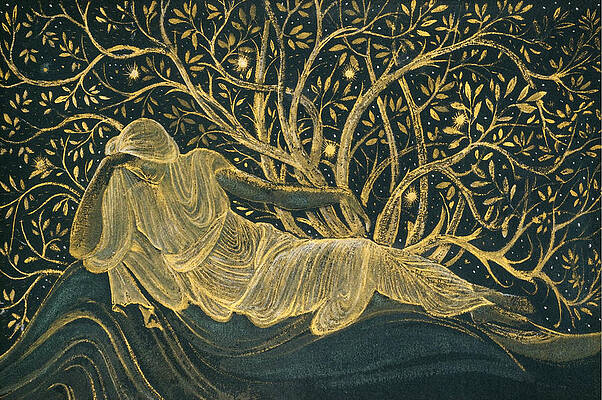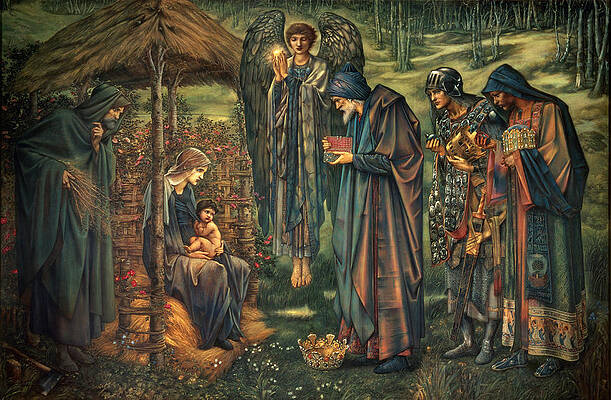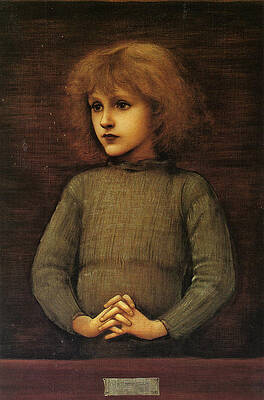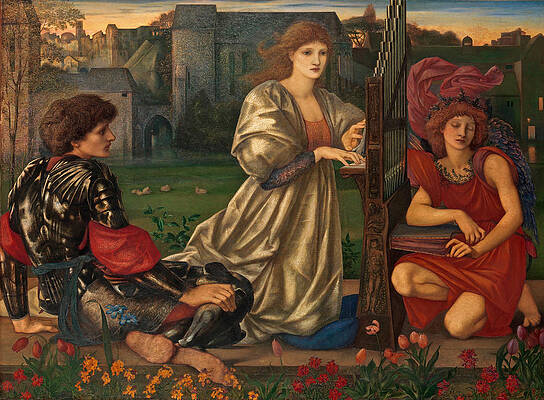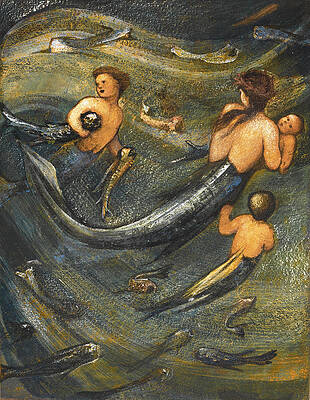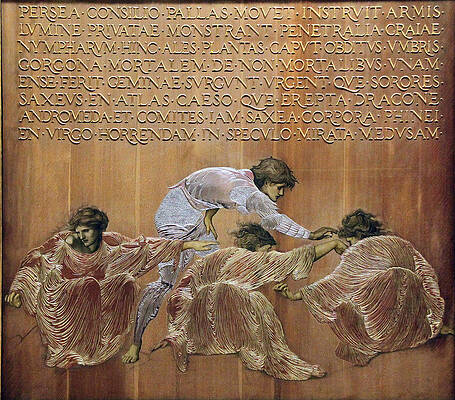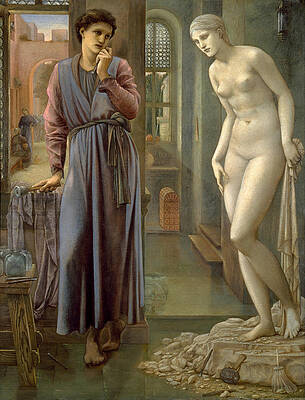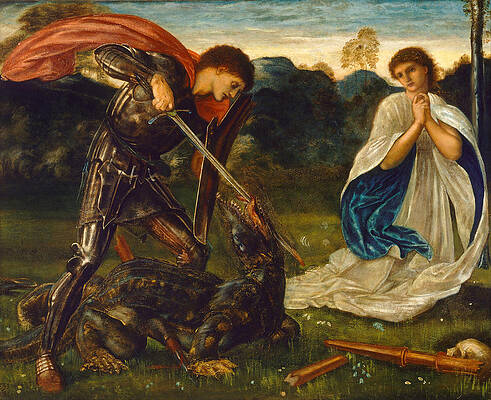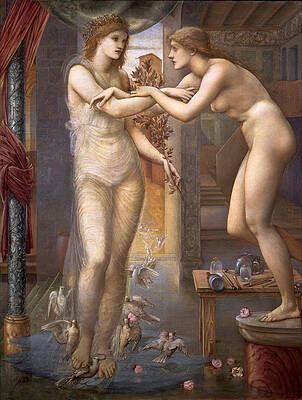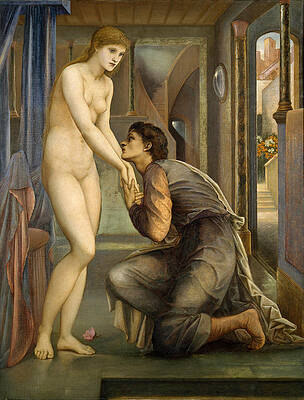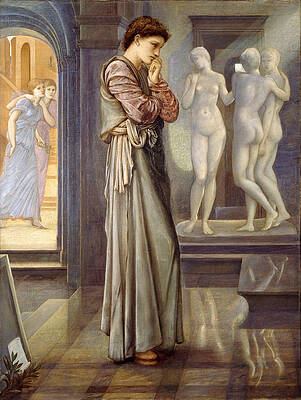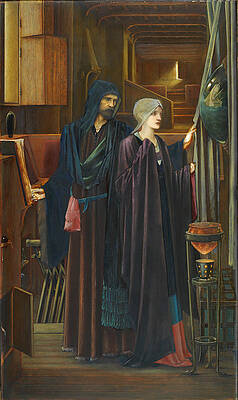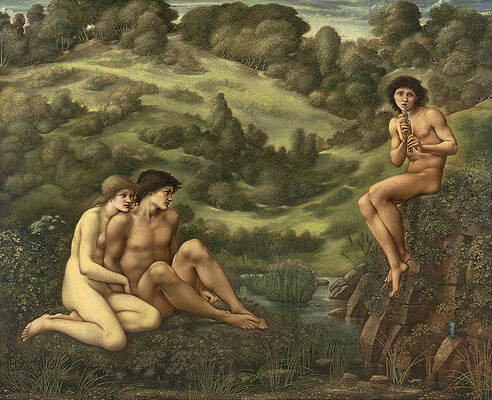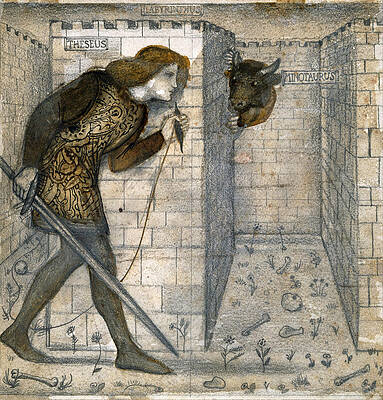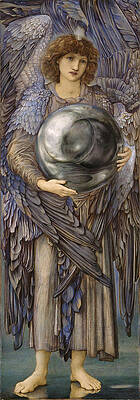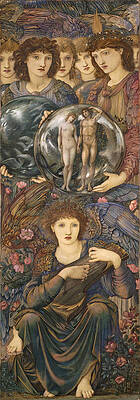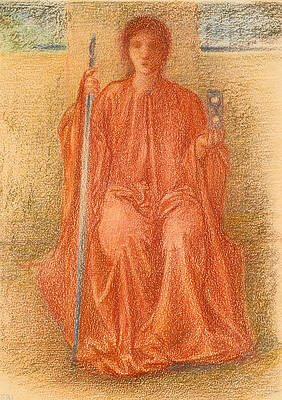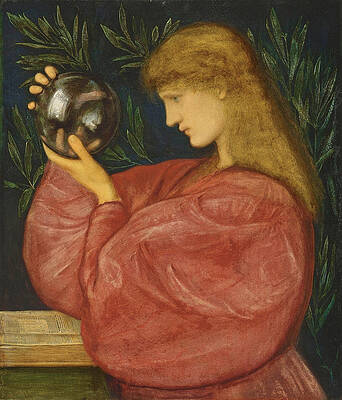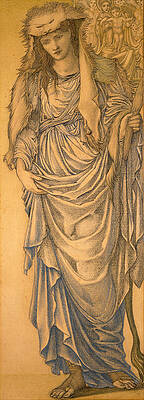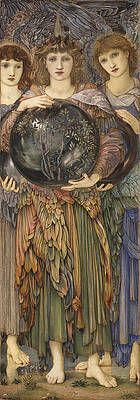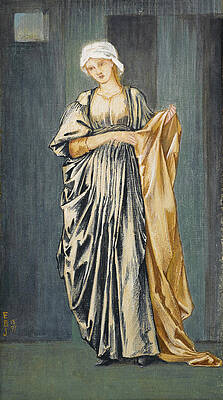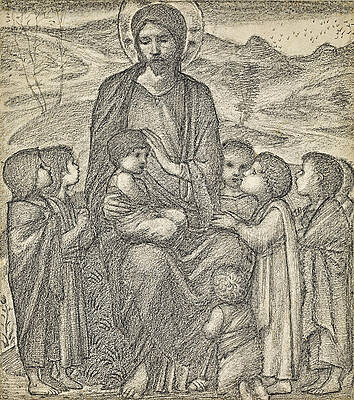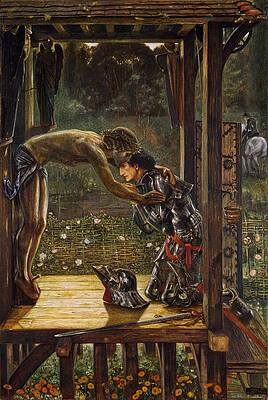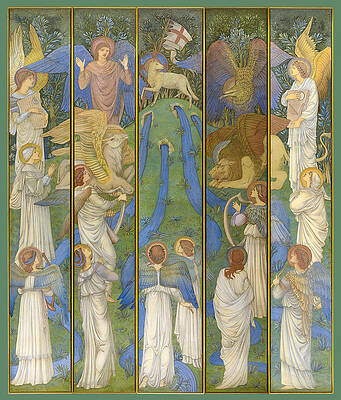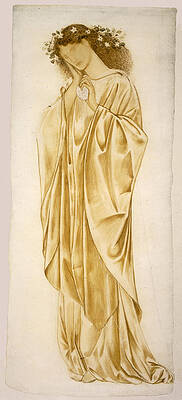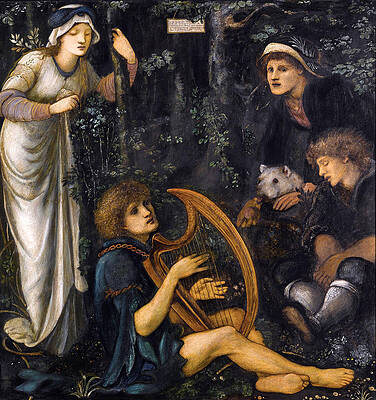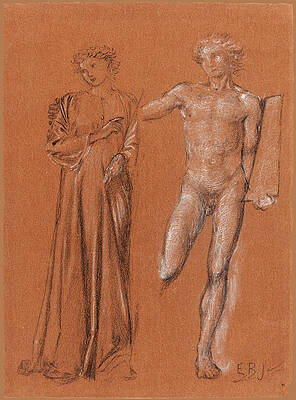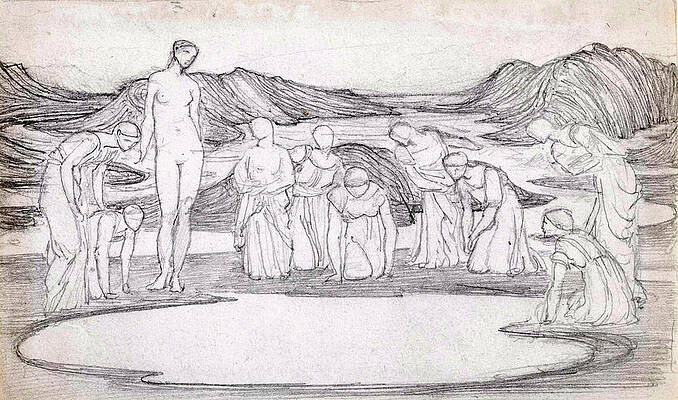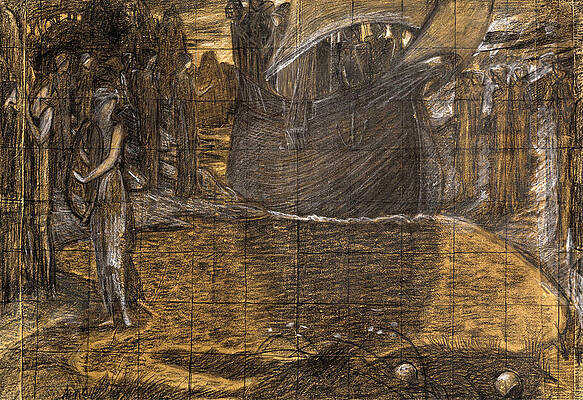Sir Edward Burne-Jones
Gemälde
A Reclining Female Figure
The Star of Bethlehem
Philip Comyns Carr
The Love Song
The Mermaid Family
Perseus and the Graiae
Pygmalion and the Image - The Hand Refrains
The fight. St George kills the dragon VI
The Feast of Peleus
Pygmalion and the Image - The Godhead Fires
Pygmalion and the Image - The Soul Attains
Pygmalion and the Image - The Heart Desires
Flamma Vestalis
The Wizard
Hope
Dancing Girls
A Sea-Nymph
The Battle of Beth-Horon - Joshua Commanding the Sun and Moon to Stand Still
The garden of Pan
Perseus and Andromeda
The Wheel of Fortune
Portrait of Maria Zambaco
The Depths Of The Sea
Theseus and the Minotaur in the Labyrinth
The Days of Creation. The First Day
The Days of Creation. The Sixth Day
Time
The Guardian Angel
Astrologia
Female Nude. Three Studies possibly for Venus
The Tiburtine Sibyl
The Days of Creation. The Third Day
Ancilla Matutina
Christ blessing Children
The Car of Love
The Merciful Knight
Paradise, with the Worship of the Holy Lamb
Maria Zambaco, Profile Study
Ariadne
The Madness of Sir Tristram
Orpheus and Eurydice
Cupid's Hunting Fields
Study for the mirror of venus
Study for the sirens

The Perseus Series - Study of Perseus in Armour for The Finding of Medusa
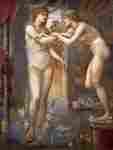
Pygmalion and the Image - The Godhead Fires
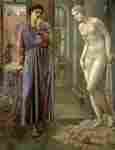
Pygmalion and the Image - The Hand Refrains

Pygmalion and the Image - The Heart Desires

Pygmalion and the Image - The Soul Attains
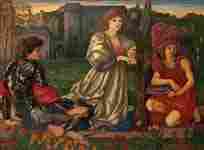
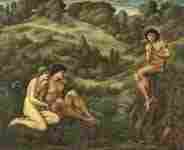
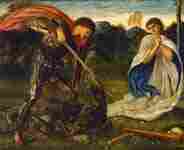
The fight: St George kills the dragon VI
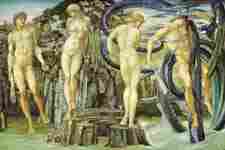


The Battle of Beth-Horon - Joshua Commanding the Sun and Moon to Stand Still

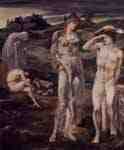

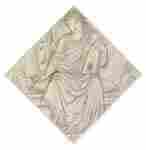

Achievment Galahad the Sang Graal
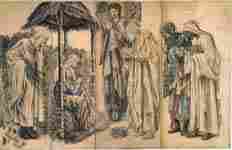
Adoration of the Magi Tapestry cartoon
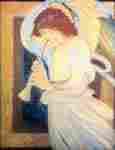
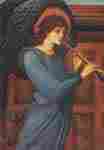
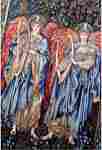

Apse mosaic of St Paul's within the Walls in Rome - Patroness of Music

Apse of St Paul's within the Walls in Rome - The Son of Man






Briar Rose - The Sleeping Beauty

Briar Rose, Garden Court (detail)
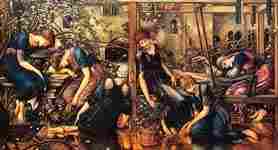
Briar Rose, Garden Court, Detail
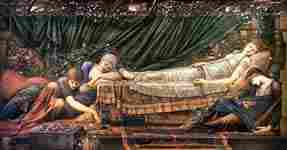
Briar Rose, Series - IV, The Sleeping Beauty
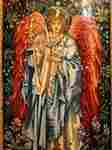
Brockhampton-by-Ross, Herefordshire, North of altar, tapestry
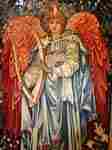
Brockhampton-by-Ross, Herefordshire, South of altar, tapestry



Christ in Glory (Salvator Mundi)
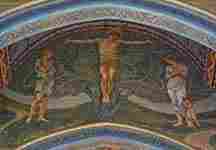
Christ on the Tree of Life (mosaic)

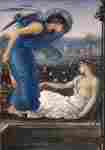
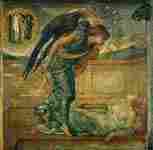

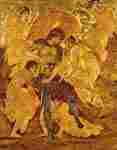
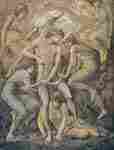





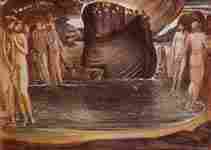
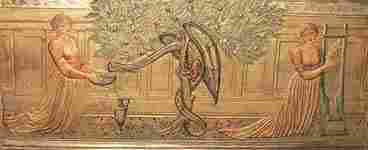
Detail from cassone by Burne-Jones
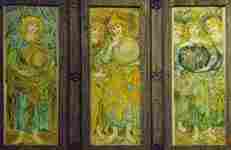
Dyfrig Chapel at Llandaff Cathedral, Cardiff - fourth panel_ 1 Days One, Two and Three (porcellan)

Dyfrig Chapel at Llandaff Cathedral, Cardiff - fourth panel_ 2 Days Four, Five and Six (porcellan)


Fair Rosamund and Queen Eleanor
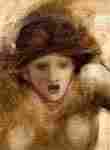

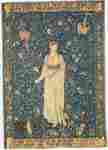

George James Howard, Earl of Carlisle (1843-1911),

Georgiana Burne-Jones, their children Margaret and Philip in the background

Goauche of Dorigen of Bretagne longing for the safe return of her husband
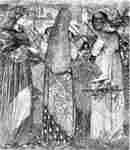

Gudrun Setting Fire To Atli's Palace


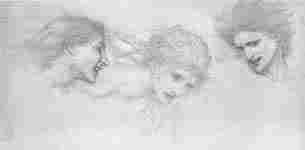
Heads of Despight, Cruelty, and Dame Amoret, study for The Masque of Cupid

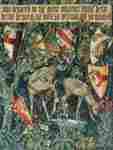
Holy Grail tapestry Verdure detail Verdure with Deer and Shields
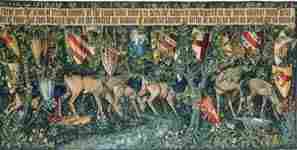

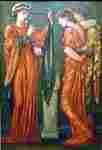
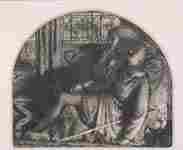
I rose up in the silent night I made my dagger sharp and bright



King Cophetua and the Beggar Maid

King Cophetua and the Beggar Maid

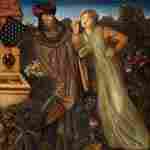
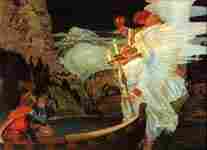

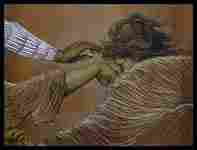


Lancelot at the Chapel of the Holy Grail,
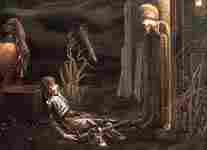
Lancelot Chapel of the Holy Grail,
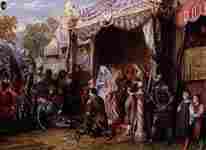
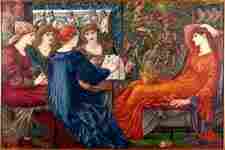

Llandaff Cathedral, Wales - The Six Days of Creation in ceramic as a reredos
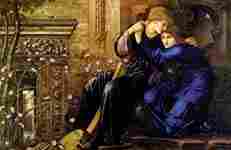
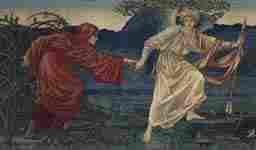
Love and the Pilgrim, tapestry
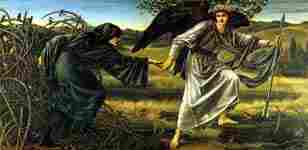
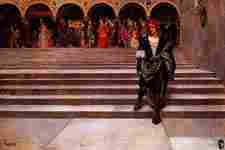
Marriage Procession. Arthur and Guinevere


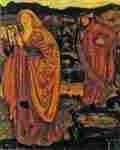
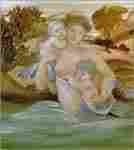
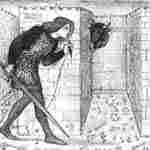

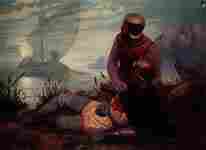

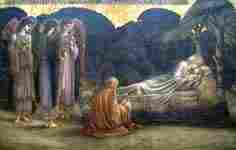
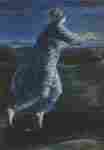


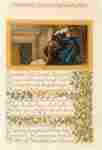
Page from an illuminated manuscript of the Rubaiyat of Omar Khayyam
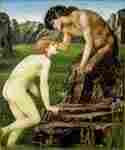
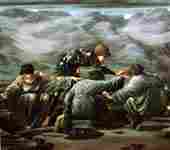
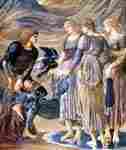



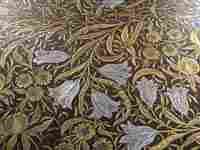
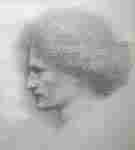
Portrait of Ignacy Jan Paderewski,


Portrait of Margaret (1866-1953), daughter of Edward Coley Burne-Jones
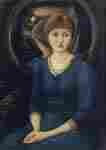
Portrait of Margaret Burne-Jones, the daughter of the painter
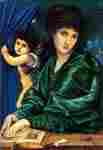
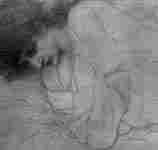

Portrait of the artist’s Family, Lady Burne Jones with her son Philip and Daughter Margaret
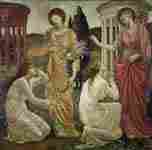
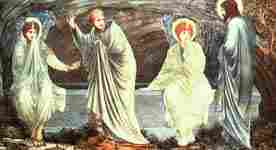

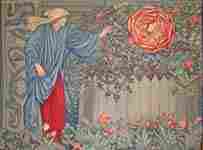
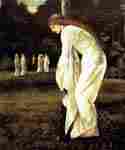
Saint George and The Dragon. The Princess Tied to the Tree,



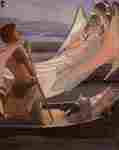
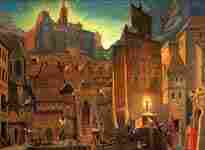
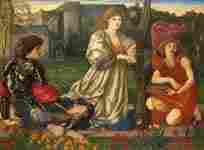


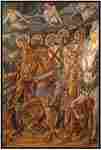
St Paul within the Walls - Burne-Jones Mosaic



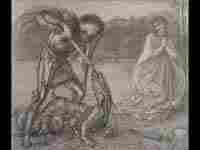
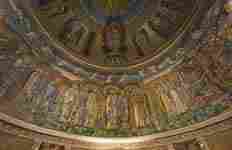
St. Paul's Episcopal church in Rome - The Saints in Bright Array (mosaic)
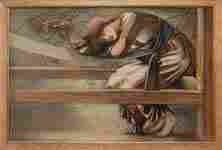
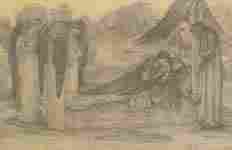
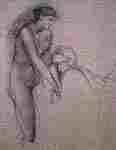
Study for The Soul Attains, Pygmalion and Galatea
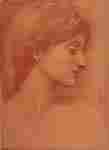
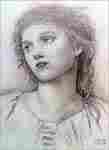

Study of a musician for The Golden Stairs

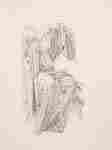
Study of drapery for Queen Morgan le Fay at the head of King Arthur

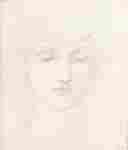


Study of the head of a girl for The Golden Stairs

Study of two girls for the Golden Stairs
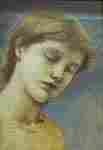


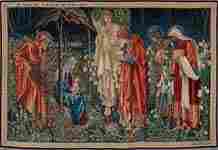

The Adoration of the Magi, tapestry, detail

The Adoration of the Magi, tapestry, detail

The Adoration of the Magi, tapestry, detail



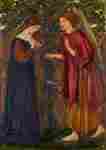
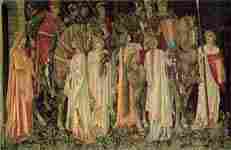
The Arming and Departure of the Knights
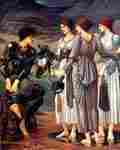

The Attainment The Vision of the Holy Grail to Sir Galahad, Sir Bors, and Sir Perceval
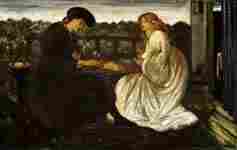

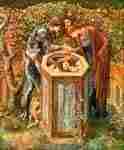


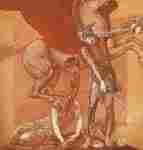
The Birth of Pegasus and Chrysaor,
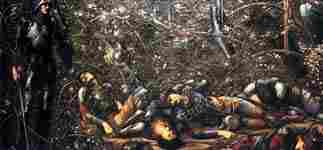
The Briar WoodThe Calling of Perseus (The Perseus Cycle 1),

The Car of Love, or Love's Wayfaring
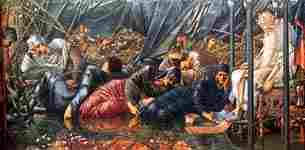

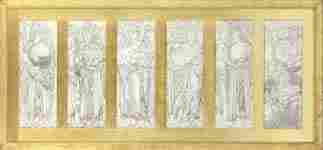
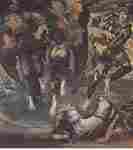
The Death of Medusa (The Perseus Cycle 5)

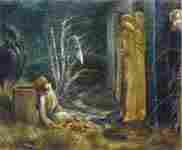
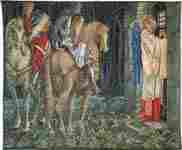
The Failure of Sir Gawaine, Sir Gawaine and Sir Uwaine at the Ruined Chapel,
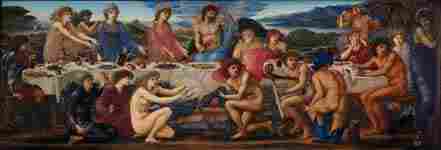
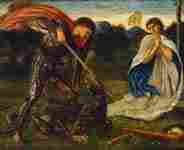
The fight- St George kills the dragon VI,
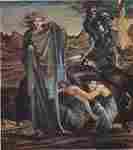
The Finding of Medusa (The Perseus Cycle 4),

The Flower Book - Arbor Tristis

The Flower Book - False Mercury
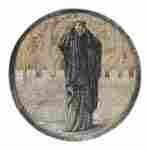
The Flower Book - Helen's Tears,
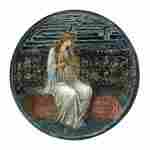
The Flower Book - Love in a Tangle,
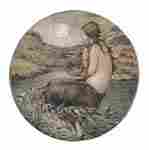
The Flower Book - Rose of Heaven
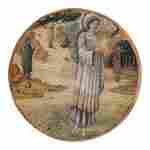
The Flower Book - Star of Bethlehem
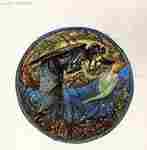
The Flower Book - Wake Dearest
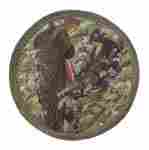
The Flower Book - Witches Tree,
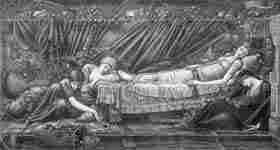

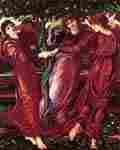

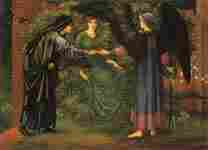
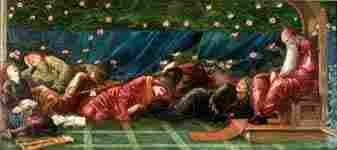
The King and His Court (small series The Wild Rose),
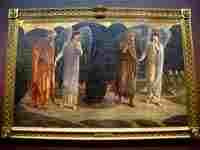
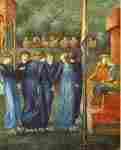
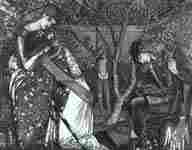
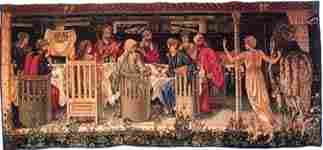
The Knights of the Round Table Summoned to the Quest by the Strange Damsel
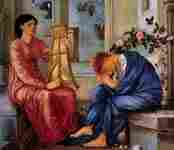
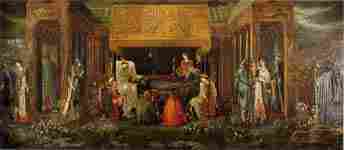
The Last Sleep of Arthur in Avalon

The Last Sleep of Arthur in Avalon, detail

The Last Sleep of Arthur in Avalon, detail

The Last Sleep of Arthur in Avalon, detail
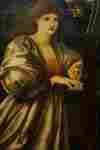
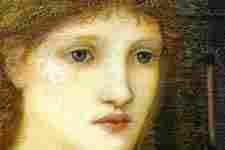
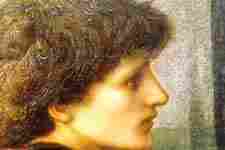
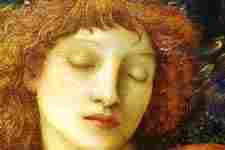
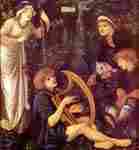
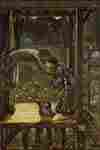

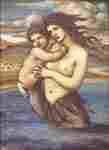
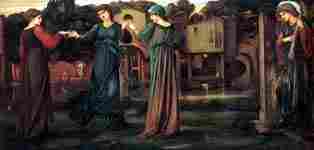
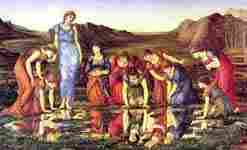

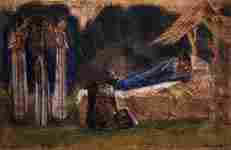
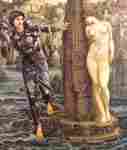
The Perseus Series. Rock of Doom
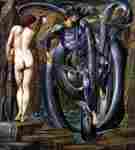
The Perseus Series. The Doom Fulfilled
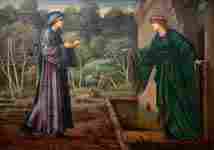
The Pilgrim at the Gate of Idleness

The Pilgrim at the Gate of Idleness, detail
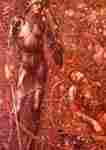
The Prince Enters the Briar Wood
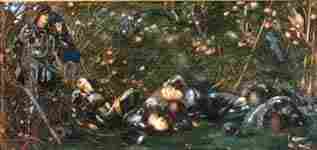
The Prince enters the forest (small series The Wild Rose)

The prince enters the thorn forest

The Princess Sabra Led to the Dragon

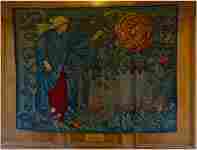
The Romance of the Rose in Rhodes House





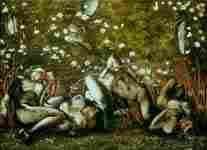

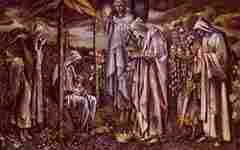



The Tree of Forgiveness, detail

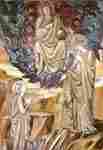
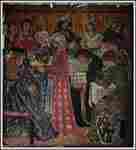

The wedding procession of Psyche

The wedding procession of Psyche, detail
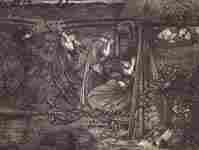

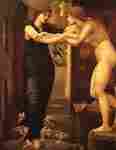
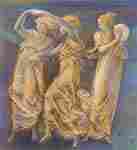
Three Female Figures Dancing And Playing
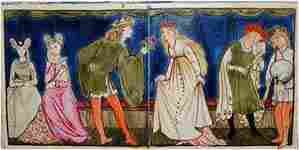
Tile designed by Burne Jones which once formed part of a fireplace at 'The Hill', Whitley, Surrey








Ariadne and Phyllis from Chaucer's 'The Legend of Good Women

Ariadne and Phyllis from Chaucer's 'The Legend of Good Women

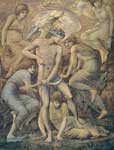
Cupid's Hunting FieldsPan and Psyche
Pygmalion, First Series
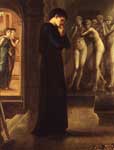
Pygmalion I , The Heart Desires
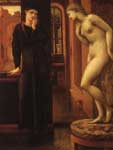
Pygmalion II, The Hand Refrains
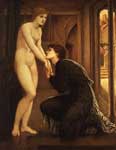
Pygmalion IV The Soul Attains,
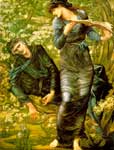
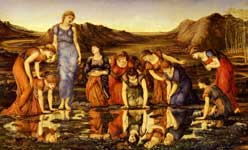

Zeichnungen

Entwurf zur Perseus-Geschichte, Szene: Das Schreckenshaupt
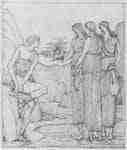
Entwurf zur Perseus-Geschichte, Szene: Perseus und die Meernymphen

Entwurf zur Perseus-Geschichte, Szene: Perseus und die Meernymphen
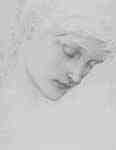


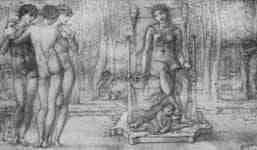



Sir Edward Coley Burne-Jones, 1. Baronet (* 28. August 1833 in Birmingham; † 17. Juni 1898 in London) war ein britischer Maler und einer der führenden Vertreter der Präraffaeliten. Er arbeitete eng mit William Morris zusammen im Bereich Buchschmuck und Textildesign sowie Glasmalerei.
Leben
Edward Burne-Jones besuchte das Gymnasium, wo er erste Karikaturen von seinen Lehrern anfertigte. Zusätzlich besuchte er mit 15 Jahren an drei Abenden in der Woche die staatliche Schule für Design. Ab 1853 studierte er Theologie am Exeter College in Oxford, wo er sich mit William Morris anfreundete und erstmals ein Werk der Präraffaeliten, John Everett Millais’s Die Rückkehr der Taube zur Arche, sah. Sein Studium schloss er nicht ab, da er unter dem Einfluss von Morris nach der gemeinsamen Besichtigung des Louvre beschloss, Künstler zu werden.
Edward Burne-Jones (links) und William Morris, 1890
Im Jahr 1856 lernte er John Ruskin und Dante Gabriel Rossetti kennen. Im gleichen Jahr verlobte er sich mit Georgiana MacDonald, einer Malerin und Holzschneiderin; sie heirateten 1860. Im Jahr 1857 unternahm er Versuche in Ölmalerei, beschäftigte sich mit Glasmalerei und schuf erste bedeutende Zeichnungen mit Bleistift und Tusche. Anfangs waren seine Arbeiten stark von Rosetti beeinflusst. Aber er profitierte er von George Frederic Watts, den er durch Rossetti kennenlernte.
Ab 1860 erfolgte der Wechsel zu Aquarellfarben. Zu den ersten Ergebnissen gehören die durch den gleichnamigen Roman des pommerschen Pfarrers und Schriftstellers Johann Wilhelm Meinhold inspirierten Bilder Sidonia und Clara von Bork, die heute in der Tate Gallery, London ausgestellt sind.[1]
Burne-Jones gehörte 1861 zu den Gründungsmitgliedern von "Morris, Marshall, Faulkner and Company" und wurde der Haupt-Designer für Glasmalerei für diese Firma. Er stellte über 500 Einzelfiguren für unterschiedliche Themen her.
1866 lernte er Maria Zambaco kennen, deren Mutter ihn mit einem Portrait von ihrer Tochter beauftragte. Burne-Jones wählte dafür "Cupid finding Psyche". Sie begannen eine außereheliche Beziehung und er malte sie oft in seinem Aterlier. Im Januar 1969 fand seine Ehefrau Georgina einen Brief von Maria in seiner Kleidung und Burne-Jones beendete widerwillig die Affaire. Aber er konnte Maria nicht aus seinen Gedanken verbannen. Er malte sie wieder und wieder, mal als Hexe, Zauberin oder Verführerin, so z. B. “The Beguiling of Merlin” (Die Verführung von Merlin). [2] Wie so oft machte Burne-Jones starke sexuelle Leidenschaft, Liebe, Betrug, Reue und Vergebung in seinen Bildern sichtbar, indem er sie in Sagen und Mythen kleidet. Damit verstärkt er die Ausdruckskraft der Erzählung. [3]
Im Jahr 1867 zog Burne-Jones mit seiner Frau in den Londoner Stadtteil Fulham. Lange Jahre stellte Burne-Jones nicht aus. Seinen Durchbruch erlebte er 1877, als mehrere Ölgemälde von ihm in der Grosvenor Gallery gezeigt wurden. Anschließend waren seine Werke auch am Glasgow Institute of the Fine Arts zu sehen.
Für die Morris Werkstätten in Merton Abbey entwarf er 1890-1895 Wandteppiche mit dem Zyklus "Die Suche nach dem Heiligen Gral" [4] und 1891 begann er mit Buch-Illustrationen für Morris Kelmscott Press. Für die Herstellung von "The Works of Geoffrey Chaucer" benötigten die beiden Künstler vier Jahre. Burne-Jones fertigte das 87 Illustrationen an für die Holzstiche von William Hooper. Viele dieser Arbeiten wurden auf der Arts and Crafts Exhibition Society ausgestellt.
Über seine Frau war Burne-Jones sowohl mit dem späteren Premierminister Stanley Baldwin als auch mit dem Schriftsteller Rudyard Kipling verwandt, die beide seine Neffen waren.
1885 wurde er Präsident der Künstlervereinigung von Birmingham. 1894 wurde er zum Baronet erhoben. Im Anschluss an die Pariser Weltausstellung 1889 wurde er für seine Werke mit dem Kreuz der Légion d’Honneur ausgezeichnet.
Er starb am 17. Juni 1898 an Herzschwäche und seine Asche wurde in der Kirche von Rottingdean, Sussex, bestattet, wo er ein Feriendomizig hatte.
Werk
Neben der Malerei beschäftigte sich Burne-Jones mit Kunsthandwerken wie Glasmalerei, Keramik, Bildwirkerei und Buchschmuck. Seine Gemälde und Illustrationen beeinflussten den französischen Symbolismus und die Art Nouveau. Bald nach seinem Tod geriet Burne-Jones’ Werk in Vergessenheit, da es in seiner Gegenständlichkeit mit seinem ornamentalen Schmuck den Prinzipien der klassischen Moderne widersprach. Erst ab den 1970er Jahren wurde es wiederentdeckt. Heute gilt Burne-Jones als einer der bedeutendsten britischen Künstler des 19. Jahrhunderts.
Chronological Catalogue of finished pictures – Appendix I. in: Malcolm Bell: Sir Edward Burne-Jones; a record and review. Publisher: G. Bell & Son Ltd., London (First ed. 1892) 1910
List of the Unfinished Pictures sold at Christie’s July 16th and 18th 1898 – Appendix II. in: Malcolm Bell: Sir Edward Burne-Jones; a record and review. Publisher: G. Bell & Son Ltd., London (First ed. 1892) 1910
List of Cartoons for Stained Glass Windows - Appendix III. in: Malcolm Bell: Sir Edward Burne-Jones; a record and review. Publisher: G. Bell & Son Ltd., London (First ed. 1892) 1910
Gemälde - unvollständig
Sidonia von Bork 1560, 1860, Aquarell und Deckfarbe, 33×17 cm, Tate Gallery, London
Clara von Bork 1560, 1860, Aquarell und Deckfarbe, 34×18 cm, Tate Gallery, London
Clerk Saunders, 1861, Aquarell, 69×42 cm, Tate Gallery, London
Der Garten der Hesperiden, 1873, Öl auf Leinwand, 119×98 cm, Hamburger Kunsthalle
Chant d'Amour, 1878, Leinwand, 112×153 cm
Das Glücksrad, 1883, Leinwand, 151×72 cm Musée d'Orsay, Paris
Der Garten des Pan, 1887, Leinwand, 152×186 cm
Der Spiegel der Venus, 1877, Leinwand, 122×201 cm Museu Calouste Gulbenkian, Lissabon
Die Geschichte des Perseus, 1875-76, Leinwand, 152×127 cm
Die goldene Treppe, 1880 Leinwand, 227×117 cm
Die Mühle, 1870-72, Leinwand, 91×198 cm
Die Tage der Schöpfung, 1877, Aquarell, 119×102 cm
Die Tiefen des Meeres, 1886, Leinwand, 196×76 cm
Die Verzauberung Merlins, 1877, Leinwand
Der Liebestempel Datum unbekannt, Öl auf Leinwand, 213,4 x 92,7 cm
Das Clemens-Sels-Museum Neuss verleiht eines seiner Spitzenwerke, das Bildnis der Maria Theresa Zambaco von Edvard Burne-Jones, an die Tate Britain in London Bildnis der Maria Theresa Zambaco, 1870, Gouache auf Pappe, 76,3 x 55 cm, Clemens-Sels-Museum, Neuss
The King's Wedding, 1870, Gouache, 32 x 26 cm, Clemens-Sels-Museum, Neuss
Werke von Burne-Jones im Delaware Art Museum, Wilmington, USA
Einzelnachweise
Edward Burne-Jones drawings in der Tate Gallery
Burne-Jones Gemälde “The Beguiling of Merlin” in Lady Lever Art Gallery
“The Beguiling of Merlin” - Bildausschnitt
Quest for the Holy Grail Tapestries in Birmingham Museums
Literatur
Laurence Binyon: Edward Burne-Jones. In: Ulrich Thieme, Felix Becker u. a.: Allgemeines Lexikon der Bildenden Künstler von der Antike bis zur Gegenwart. Band 5, E. A. Seemann, Leipzig 1911, S. 265ff.
Georgiana Burne-Jones: Memorials of Edward Burne-Jones. By G.B-J. Publisher: The McMillan Company, London 1906 (new edition two volumes in one)
Otto von Schleinitz:Burne-Jones. Verlag: Velhagen & Klasing, Bielefeld 1901
Sir Edward Burne-Jones by L. T. Meade in: THE STRAND Magazine, No. 55 July 1895
The beginning of the world; Twenty-five pictures by Edward Burne Jones. New Edition. Longmans, Green & Co., London 1903. Foreword by Georgina Burne-Jones.
Edward Burne-Jones – Victorian Artist-Dreamer, The Metropolitan Museum of Art, New York 1999
Fiona MacCarthy: The last Pre-Raphaelite : Edward Burne-Jones and the Victorian imagination, Faber, London 2011, ISBN 978-0-571-22861-4
Judith Flanders: A Circle of Sisters. Publisher: W. W. Norton & Co.; (2 Jun 2005) ISBN 978-0-3930-5210-7
----
Fine Art Prints | Grußkarten | Handyhüllen | Lebensstil | Herren , Damen Bekleidung | Wohnkultur | Puzzles | Notizbücher | Wandteppiche | ...
----
Künstler
A - B - C - D - E - F - G - H - I - J - K - L - M -
N - O - P - Q - R - S - T - U - V - W - X - Y - Z
Von Wikipedia, Der Text ist unter der Lizenz „Creative Commons Attribution/Share Alike“ verfügbar; zusätzliche Bedingungen können anwendbar sein. Einzelheiten sind in den Nutzungsbedingungen beschrieben


